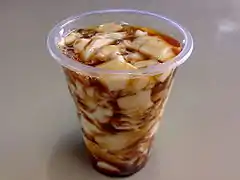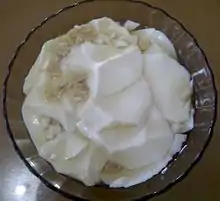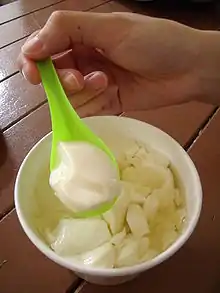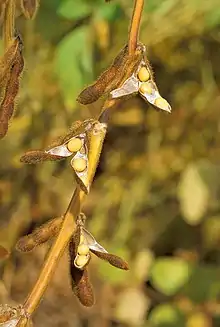Douhua
Douhua (Chinese: 豆花; pinyin: dòuhuā) is the short form of doufuhua (Chinese: 豆腐花; pinyin: dòufuhuā). It is a Chinese snack made with very soft tofu. It is also referred to as tofu pudding,[1] soybean pudding,[2] or tofu brains.[3]
 This Douhua was purchased from Qingdao, which represents the Northern Chinese cuisine. | |
| Alternative names | Doufuhua, tofu pudding, soybean pudding |
|---|---|
| Type | Snack |
| Place of origin | China |
| Region or state | East Asia and Southeast Asia |
| Main ingredients | Tofu |
| tofu pudding | |||||||||||||||||||||
|---|---|---|---|---|---|---|---|---|---|---|---|---|---|---|---|---|---|---|---|---|---|
| Chinese | 豆腐花 | ||||||||||||||||||||
| Literal meaning | bean curd flower | ||||||||||||||||||||
| |||||||||||||||||||||
| Alternative Chinese name | |||||||||||||||||||||
| Traditional Chinese | 豆腐腦 | ||||||||||||||||||||
| Simplified Chinese | 豆腐脑 | ||||||||||||||||||||
| |||||||||||||||||||||

Origin
Tofu is thought to originate in ancient China during the Han Dynasty. Liu An, the grandson of Emperor Gaozu of Han, was ambitious and wanted to invent something to live forever. He used soybean and bittern and finally got niveous and tender tofu. People named it "tofu brains" because of its softness. Tofu brains then became a popular snack during Han Dynasty.[4]
Development
During the War of Resistance, Sichuan became the political, economical, and military center. A famous Douhua restaurant boss,Liu Xilu kept innovating techniques, learning from different perspectives and finally got his own recipes, which greatly improved the taste of Douhua. His new recipe quickly spread in China.[5]
Taste & Cuisine
Northern Chinese cuisine
In Northern China, Douhua is often eaten with soy sauce, thus resulting in a savory flavor. Northern Chinese often refer to Douhua as tofu brains. Each region may differ in seasonings. Inland cities add chopped meat, pickles, and mushrooms, while coastal cities add kelps and small shrimps. [6] Tofu brains can be found at breakfast stands along the streets in the morning, usually with eggs or youtiao (fried dough sticks). Other times it is hard to find outside of a restaurant.[7]
Sichuan cuisine
Douhua in Sichuan highly stresses the flavor of spicy, which differs from traditional favors of soy or sweet. It is served by carrying pole or bicycle vendors with several condiments such as chili oil, soy sauce, scallions, and nuts. A famous Sichuan dish, spicy tofu fish uses Douhua as an essential ingredient.[8]
Southern Chinese cuisine
In Southern China, Douhua is often eaten with sweet flavoring. Southern China often refers to Douhua as tofu pudding. It is served with sweet ginger or clear syrup. In summer, people eat cold Douhua to relieve themselves of the heat. In winter, people add hot sweet water and beans into Douhua to dispel cold. Hong Kong people add sesame paste into Douhua. Taiwanese and Guangdong Douhua are symbolic of Southern Chinese cuisine.[9]
Filipino cuisine

In the Philippines, fresh silken tofu served in sweet brown syrup is known as taho and sold by hawkers in the mornings, usually door-to-door and in public plazas, or outside churches. In some regional variations, taho is often served with sugarcane syrup or strawberry syrup.
Indonesian cuisine

In Indonesia, it is known as Kembang tahu or in Java as Tahwa derived from the Chinese Hokkien name Tau Hwe, or Wedang Tahu (Wedang means hot water with ginger, Tahu means tofu) and is usually sold by hawkers. It is served warm or cold with palm sugar syrup that has been flavored with pandan leaves and ginger.
Malaysian and Singaporean cuisine

In Malaysia and Singapore, it is more commonly known by its names tau hua or tau huay in Hokkien, or by the Cantonese name (tau fu fa), with the Cantonese variation being more common in Malaysia. In Penang, the common term is tau hua, due to Hokkien being its dominant local Chinese language.
It is usually served either with a clear sweet syrup alone, with ginkgo seeds suspended in the syrup, or in a sugar syrup infused with pandan. Alternatively, it can also be served with palm-syrup (Gula Melaka).
Thai cuisine
In Thailand, it is known by its Chinese Hokkien name taohuai (เต้าฮวย). It is usually served cold with milk and fruit salad, which is known as taohuai nom sot (เต้าฮวยนมสด, literally "douhua in fresh milk") or taohuai fruit salad (เต้าฮวยฟรุตสลัด), or served hot with ginger syrup, which is known as taohuai nam khing (เต้าฮวยน้ำขิง).
Vietnamese cuisine
In Vietnam, it is known as tàu hủ nước đường, tàu hủ hoa or tào phớ, đậu hủ, tàu hủ. It varies in three regions in Vietnam:
- Northern region — served with jasmine infused sugary water. It is enjoyed as warm in winter and cold with ice in summer.
- Central region — cooked with spicy ginger. Sugar is added. Douhua pieces are usually unshaped because of their softness.
- Southern region — served warm with lychee and coconut water. Ginger is optional. Douhua pieces are firmer than those in the North and the Central.
Packaged
The dessert is also sold in North American Asian supermarkets in plastic containers.
Requirements
Like all tofu, douhua must have a coagulant, often gluconolactone for smoothness as compared with other coagulants.
In popular culture
- Tofu pudding was featured on the Netflix TV series, Street Food in season 1.[10]
See also
| Wikimedia Commons has media related to Soybean pudding. |
- Dim sum
- Tofu
- Taho
- List of tofu dishes
 Food portal
Food portal
References
- "Tofu Pudding (Douhua)". China Sichuan Food. Archived from the original on 19 June 2020. Retrieved 28 September 2020.
- "SOYBEAN PUDDING WITH GINGER SYRUP (DOUHUA)". Cookmorphosis. Archived from the original on 11 November 2019. Retrieved 28 September 2020.
- "(豆腐脑 dòufu nǎo)". Into the Middle Kingdom. Archived from the original on 11 October 2015. Retrieved 28 September 2020.
- "豆花的饮食文化:历史由来". www.weibacanyin.com. Retrieved 2020-12-06.
- "豆腐脑的来历 - 快资讯". www.360kuai.com. Retrieved 2020-12-06.
- "豆腐脑_360百科". baike.so.com. Retrieved 2020-12-09.
- "豆腐脑市场价格多少钱一碗 单卖豆腐脑生意怎么样 - 致富热". www.zhifure.com. Retrieved 2020-12-09.
- "豆腐脑_360百科". baike.so.com. Retrieved 2020-12-06.
- "豆腐脑_360百科". baike.so.com. Retrieved 2020-12-06.
- Joshua Samuel Brown (22 May 2019). "Taiwan Culture and Cuisine Shine on New Netflix Series "Street Food"". CommonWealth Magazine. Commonwealth Magazin Group. Archived from the original on 20 December 2019. Retrieved 28 September 2020.

